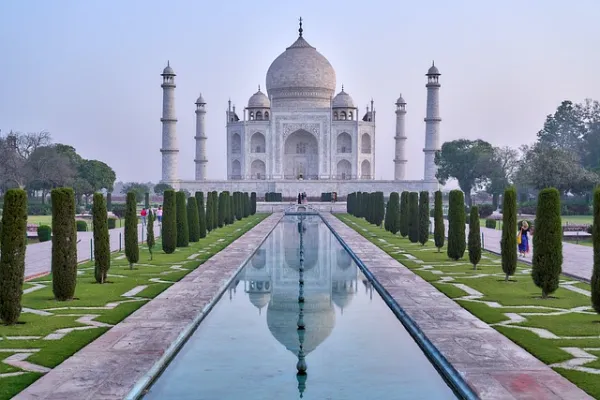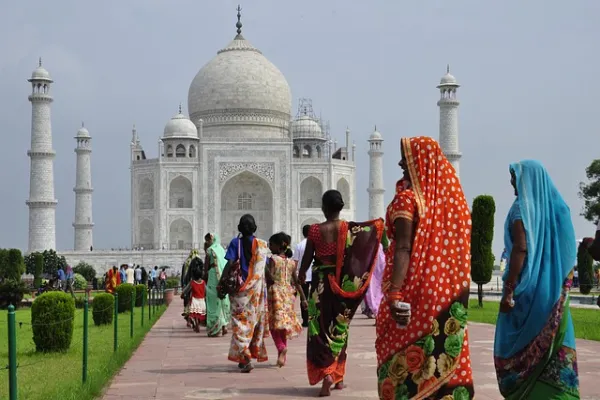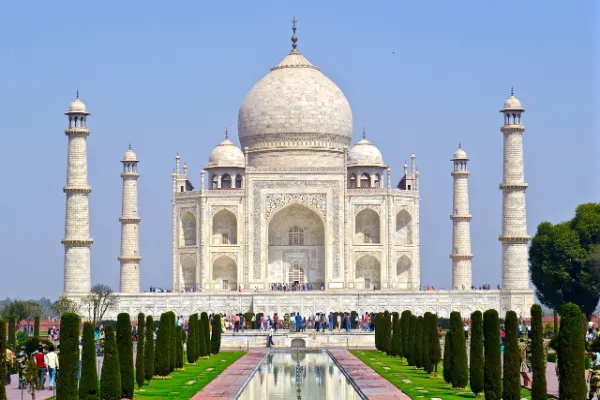Interesting Facts About Taj Mahal: From White to Gold

The Taj Mahal: A Monument Steeped in History and Fascinating Facts
There are many interesting facts about Taj Mahal. Towering majestically on the banks of the Yamuna River in Agra, India, the Taj Mahal is a timeless monument that has captivated hearts for centuries. Its pristine white marble facade, intricate details, and symmetry have earned it a place as one of the New Seven Wonders of the World. But beyond its breathtaking beauty lies a rich tapestry of history and fascinating facts, waiting to be unraveled.
What are the interesting facts about Taj Mahal?
The Taj Mahal holds a treasure trove of interesting facts. From its color-changing marble to the myths surrounding its construction, the monument intrigues me. The intricate details, like the 28 types of precious stones inlaid within the white marble and the story of the hidden tombs beneath the mausoleum, add layers of depth to its beauty.
A Love Story Etched in Stone: The Interesting Facts About Taj Mahal
The Taj Mahal’s origin story is perhaps its most well-known and deeply touching aspect. It was commissioned in 1632 by the Mughal emperor Shah Jahan as a final resting place for his third wife, Mumtaz Mahal. Mumtaz, meaning “Jewel of the Palace,” was Shah Jahan’s confidante, constant companion, and love of his life. Her tragic death during childbirth in 1631 left the emperor inconsolable. To immortalize his love, Shah Jahan embarked on the ambitious project of building the Taj Mahal, a monument that would forever showcase his devotion. Rising majestically on the banks of the Yamuna River in Agra, India, stands the Taj Mahal.
This immense mausoleum, crafted from gleaming white marble, is a marvel of Mughal art and a UNESCO World Heritage Site. Built between 1631 and 1648 by Emperor Shah Jahan, it serves as a timeless testament to his love for his wife Mumtaz Mahal. Recognized as one of the world’s most admired masterpieces, the Taj Mahal continues to captivate visitors with its beauty, intricate details, and profound story. Keep reading for more interesting facts about Taj Mahal.
Taj Mahal is a Marvel of Architecture and Design

The construction of the Taj Mahal was a mammoth undertaking. It took over 22 years and an estimated 20,000 artisans and laborers to complete the structure. The emperor envisioned a monument that transcended the boundaries of the ordinary, and the result is a masterpiece of Mughal architecture.
- The Dazzling Marble: The Taj Mahal gleams with white Makrana marble, meticulously quarried from over 200 miles away. This marble possesses a unique property; its color appears to change throughout the day. It reflects a pinkish hue at dawn, a pearly white during the day, and a golden glow under the moonlight.
- Symmetry and Precision: The Taj Mahal’s design embodies perfect symmetry on a north-south axis. From the four minarets flanking the central dome to the placement of decorative elements, every detail reflects a sense of harmony. This symmetry extends to the tomb placements below the main chamber, where both Mumtaz Mahal and Shah Jahan lie entombed.
- A Fusion of Styles: Mughal architecture is a blend of Persian, Indian, and Islamic influences, and the Taj Mahal exemplifies this beautifully. The bulbous dome owes inspiration to Timurid and Persian styles, while the intricate floral designs and inlay work reflect Indian artistic traditions. Calligraphic inscriptions adorning the monument showcase Islamic art forms.
- Jewel-Toned Grandeur: The white marble facade of the Taj Mahal isn’t its only adornment. Over 28 types of precious and semi-precious stones were meticulously inlaid onto the marble. Lapis lazuli, carnelian, jade, turquoise, and amethyst are just a few examples, each meticulously chosen for its color and symbolism.
Beyond the Facade of the Taj Mahal: Unveiling the Taj’s Secrets
The Taj Mahal holds more secrets than one might expect. Here are some intriguing facts that add another layer of depth to this magnificent structure:

- The Myth of Black Taj: A persistent legend suggests Shah Jahan planned a black marble mausoleum for himself to mirror the Taj Mahal. However, historical evidence and the practicalities of working with black marble make this unlikely.
- The Myth of Mutilated Hands: Another legend claims the artisans who built the Taj Mahal had their hands chopped off to prevent them from replicating its magnificence. This is a common folktale associated with many grand structures and lacks historical basis.
- The Sacrifices Made: The sheer scale of the Taj Mahal’s construction required immense resources and manpower. While the emperor ensured fair wages for the workers, the project undoubtedly demanded effort from all involved.
- The Hidden Cenotaphs: The intricately decorated tombs we see inside the Taj Mahal are actually cenotaphs, symbolic tombs elevated above the actual burial chambers. The real tombs lie in a less ornate chamber below, following Islamic traditions that discourage elaborate decorations on graves.
- The Disappearing Act: The Taj Mahal faces a constant threat from environmental pollution. The white marble is particularly susceptible to acid rain and discoloration. Ongoing efforts are in place to preserve this architectural marvel for generations to come.
- The Enduring Legacy: Despite the challenges, the Taj Mahal continues to be a symbol of love, architectural excellence, and cultural heritage. It attracts millions of visitors each year, inspiring awe and admiration.
The Taj Mahal Facts: A Story Yet to be Fully Told
The Taj Mahal’s story is far from over. New research and discoveries continue to shed light on its construction techniques, the lives of the artisans involved, and the emperor’s vision. Though its construction is well documented, the Taj Mahal’s story remains a work in progress.
Research delves into the lives of the artisans who breathed life into the emperor’s vision. Perhaps the most fascinating chapters are yet to be written. As we analyze construction techniques and uncover the nuances of Shah Jahan’s grand plan, the Taj Mahal continues to whisper secrets.
The way you described the Taj Mahal’s symmetrical design and the use of white marble paints a breathtaking picture. It’s no wonder it’s considered one of the most beautiful buildings in the world. As an architecture enthusiast, I’m curious to learn more about the Mughal architectural style reflected in the Taj Mahal. Are there any other structures influenced by this style that people would recommend exploring? Understanding the broader context of Mughal architecture would further enrich the appreciation for the Taj Mahal’s unique design.
This article is glimpse into the rich history behind the Taj Mahal! Learning about Shah Jahan’s vow to his wife Mumtaz Mahal adds a deeper emotional layer to the monument’s grandeur. The architectural details you mentioned, particularly the use of semi-precious stones and the intricate calligraphy, are truly inspiring. For any history buffs out there, are there any lesser-known aspects of the Taj Mahal’s construction or symbolism that you find interesting? Perhaps there are historical accounts or architectural features that shed new light on the monument’s significance? Sharing these hidden facts would be a great way to enter deeper into the amazing story of the Taj Mahal.